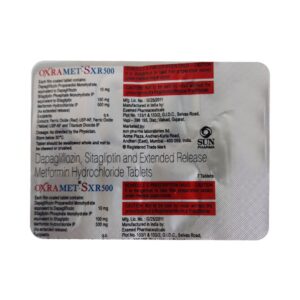METFORMIN + SITAGLIPTIN PHOSPHATE + DAPAGLIFLOZIN
Metformin: Metformin is a widely prescribed oral medication used to treat Type 2 diabetes. It belongs to a class of drugs called biguanides. Metformin helps control blood sugar levels by reducing the amount of glucose produced by the liver and increasing the body’s sensitivity to insulin.
The primary use of Metformin is to lower blood sugar levels in individuals with Type 2 diabetes, which helps prevent complications associated with high blood sugar, such as kidney damage, nerve problems, and blindness. It is often prescribed alongside diet and exercise to achieve better glycemic control.
The recommended starting dose of Metformin for adults is usually 500 mg to 850 mg taken once or twice daily with meals. The dose may be gradually increased over time based on blood sugar response and tolerance, up to a maximum of 2000 mg per day. Extended-release formulations are also available, allowing for once-daily dosing.
Like any medication, Metformin can cause side effects. Common side effects include gastrointestinal discomfort, such as diarrhea, nausea, vomiting, and stomach pain. These side effects are usually temporary and can be minimized by starting with a low dose and gradually increasing it. In rare cases, metformin can cause a serious but rare side effect called lactic acidosis, which is more likely to occur in individuals with kidney or liver problems.
Other relatively rare side effects may include dizziness, headache, metallic taste in the mouth, and low blood sugar (hypoglycemia). It is essential to monitor blood sugar regularly while taking Metformin to ensure proper dosage and prevent hypoglycemia.
It is important to note that Metformin is not typically recommended for individuals with severe kidney or liver disease, heart failure, or a history of lactic acidosis. Pregnant or breastfeeding women should consult their healthcare provider before taking this medication.
Overall, Metformin is a commonly prescribed drug for Type 2 diabetes due to its effectiveness in controlling blood sugar levels and its relatively low risk of side effects. It is essential to discuss any concerns or questions about this medication with a healthcare professional.
Sitagliptin Phosphate: Sitagliptin Phosphate is a prescription medication used in the treatment of type 2 diabetes mellitus. It falls into the class of drugs known as dipeptidyl peptidase-4 (DPP-4) inhibitors.
The main mechanism of action of Sitagliptin Phosphate is to increase the levels of incretin hormones in the body. Incretins are natural substances that help regulate blood sugar levels by increasing the production of insulin after meals and reducing the amount of glucose produced by the liver. Sitagliptin works by inhibiting the enzyme DPP-4, which quickly breaks down incretins, thus increasing their levels in the body. Ultimately, this helps to control blood sugar levels in patients with type 2 diabetes.
The usual recommended starting dose of Sitagliptin Phosphate is 100 mg taken by mouth once daily. It can be taken with or without food. However, the dosage may need adjustment in patients with kidney problems or those taking certain other medications. It is essential to follow the instructions and dosage prescribed by your doctor.
As with any medication, Sitagliptin Phosphate may cause side effects. Common side effects include headache, upper respiratory tract infection, sore throat, nausea, and stomach pain. In some cases, it can also cause more serious side effects such as pancreatitis (inflammation of the pancreas), allergic reactions, joint pain, and skin reactions. It is important to seek medical attention if you experience any severe side effects or have concerns.
Please note that this is a general overview of Sitagliptin Phosphate, and the information provided here should not replace the advice of your healthcare provider. It is crucial to consult your doctor or pharmacist for specific information regarding your individual circumstances.
Dapagliflozin: Dapagliflozin is a medication primarily used in the treatment of type 2 diabetes. It belongs to a class of drugs known as sodium-glucose cotransporter 2 (SGLT2) inhibitors. It is commonly sold under the brand name Farxiga.
The primary mechanism of action of dapagliflozin is the inhibition of SGLT2 in the kidneys. SGLT2 is responsible for reabsorbing glucose from the filtered fluid in the kidneys back into the bloodstream. By inhibiting SGLT2, dapagliflozin prevents the reabsorption of glucose and allows excess glucose to be excreted in the urine. This helps to lower blood glucose levels in individuals with type 2 diabetes.
The recommended starting dose of dapagliflozin is typically 5 mg taken orally once daily. It can be taken with or without food. The dosage can be increased to 10 mg once daily depending on the patient’s response and tolerability. It’s important to follow the dosage instructions prescribed by the healthcare provider.
Some common side effects of dapagliflozin include urinary tract infections, genital mycotic (fungal) infections, and increased urination. These side effects are more common in women and can be managed by maintaining good personal hygiene. Other possible side effects may include hypotension (low blood pressure), dizziness, dehydration, increased cholesterol levels, and increased risk of diabetic ketoacidosis. It’s crucial to discuss any unusual or severe side effects with a healthcare professional.
It’s important to note that dapagliflozin should not be used by individuals with type 1 diabetes or diabetic ketoacidosis. It may also interact with other medications, so it’s necessary to inform the healthcare provider about all the medications being taken before starting dapagliflozin. Additionally, it is essential to follow a healthy diet and exercise regularly while taking dapagliflozin to effectively manage blood glucose levels.

